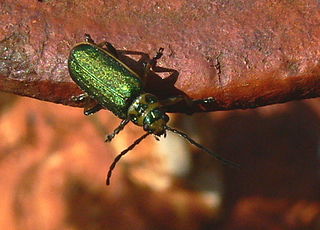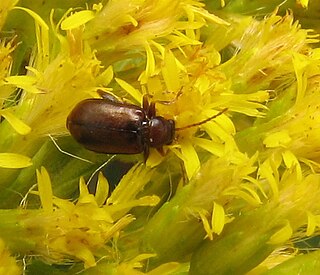
The flea beetle is a small, jumping beetle of the leaf beetle family (Chrysomelidae), that makes up the tribe Alticini which is part of the subfamily Galerucinae. Historically the flea beetles were classified as their own subfamily.

The Galerucinae are a large subfamily of the leaf beetles (Chrysomelidae), containing about 15,000 species in more than 1000 genera, of which about 500 genera and about 8000 species make up the flea beetle tribe Alticini.
Psyllototus is an extinct genus of flea beetles described from the late Eocene Rovno amber of Ukraine, and from the Baltic amber of Russia and Denmark. It was named by Konstantin Nadein and Evgeny Perkovsky in 2010, and the type species is Psyllototus progenitor. In 2016, a newly described extant flea beetle genus from Bolivia, Chanealtica, was found to be most similar to Psyllototus, based on the characters available for observation.
Chaetocnema rileyi, the Boca Chica flea beetle, is a species of flea beetle in the family Chrysomelidae. It is found in North America.

Luperaltica nigripalpis is a species of flea beetle in the family Chrysomelidae. It is found in North America.
Altica knabii is a species in the tribe Alticini, in the subfamily Galerucinae . It is found in North America. It overwinters in leaf litter and is associated with Oenothera biennis.
Longitarsus melanurus is a species of flea beetle in the family Chrysomelidae. It is found in North America.
Glyptina spuria is a species of flea beetle in the family Chrysomelidae. It is found in North America.
Kuschelina jacobiana is a species of flea beetle in the family Chrysomelidae. It is found in North America.

Kuschelina gibbitarsa, the flea beetle, is a species of flea beetle in the family Chrysomelidae. It is found in North America.
Disonycha balsbaughi is a species of flea beetle in the family Chrysomelidae. It is found in North America.
Systena marginalis, the margined systena, is a species of flea beetle in the family Chrysomelidae. It is found in North America.

Phyllotreta undulata, known generally as the small striped flea beetle or turnip flea beetle, is a species of flea beetle in the family Chrysomelidae. It is found in Australia, Europe and Northern Asia, North America, and Oceania.
Acallepitrix is a genus of flea beetles in the family Chrysomelidae. There are more than 20 described species in Acallepitrix. They are found in the Neotropics, Central America, and North America.
Aulacothorax is a genus of flea beetles in the family Chrysomelidae. There are currently 51 described species in Aulacothorax found worldwide, 40 of which are found in the Indomalayan realm.
Hornaltica is a genus of flea beetles in the family Chrysomelidae. There is only one described species, H. bicolorata, found in North America.
Pachyonychus is a genus of flea beetles in the family Chrysomelidae containing a single described species, P. paradoxus, from the United States.

Blepharida is a genus of leaf beetles of the subfamily Galerucinae. They have co-evolved with plants in the genus Bursera, which they feed on. The plants have developed a sticky, poisonous resin that sprays out when the leaves are bitten into, and the beetles have evolved to cut through the veins of the leaves to disable this mechanism first. There are currently 73 known species in Blepharida, which are found in the Nearctic, Neotropical, Afrotropical and southern Palearctic realms.

Podontia is a genus of flea beetles in the family Chrysomelidae. They belong in the Blepharida-group of flea beetles.






